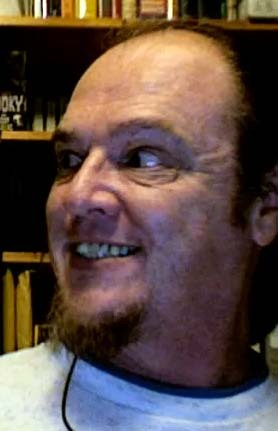More 1980s Letterers Part 3
 From MOONSHADOW #2, May 1985, Marvel, image © J.M. DeMatteis & Jon J. Muth
From MOONSHADOW #2, May 1985, Marvel, image © J.M. DeMatteis & Jon J. MuthContinuing with a third and final batch of letterers who began in the 1980s. Kevin Nowlan is a comics artist revered for his appealing and individual style over the past five decades, and his lettering is equally appealing and individual. It’s based on the work of Gaspar Saladino, but even from the start he carried that style further into his own territory, as seen above. Nowlan didn’t do a lot of lettering, but when he did, it stood out from the crowd. The reproduction and size of this page from MOONSHADOW isn’t great, but Nowlan’s mixed case script captions and wavy balloons are still remarkably stylish.
 Kevin Nowlan at Baltimore Comic-Con, 2019
Kevin Nowlan at Baltimore Comic-Con, 2019Kevin C. Nowlan was born Feb 7, 1958 in Chadron, Nebraska, the youngest of six children. In an interview with Bob McLeod published by TwoMorrows, Kevin said there was a lot of artistic talent in his family, though he was the only one who pursued art as a career. He went to a trade school that taught design and a minimal amount of illustration. After graduation, Kevin found a job in a print shop and worked on his comics drawing samples. Sending them to fanzines and comics publishers eventually paid off when he landed his first job at Marvel. He felt he wasn’t ready, but editor Al Milgrom told him to do it anyway. That was in 1983.
 From DALGODA #6, Oct 1985, © Fantagraphics
From DALGODA #6, Oct 1985, © FantagraphicsWhile Kevin’s earliest work at Marvel was lettered by others, for Fantagraphics he did both art and lettering on the backup feature in DALGODA, “Grimwood’s Daughter,” example above, giving a closer look at his lettering. The letters are made with a wedge-tipped pen, and again are very much in the style of Gaspar Saladino, but carrying Gaspar’s shapes even further. The balloon shapes have thin outlines, and are made with oval templates and a straight edge. I was impressed with it when I first saw it, particularly since I was also trying to imitate Saladino, but not doing it nearly as well.
 From TOMORROW STORIES #2, Nov 1999, America’s Best Comics, image © DC Comics
From TOMORROW STORIES #2, Nov 1999, America’s Best Comics, image © DC ComicsJumping ahead to 1999, Kevin was the artist, letterer, and co-creator with Alan Moore of Jack B. Quick in TOMORROW STORIES. I loved every panel, and was able to work with Kevin on the covers he did for the series. The logo design is his, and Kevin also famously designed the HELLBOY logo for Mike Mignola.
 From IMMORTAL HULK: TIME OF MONSTERS #1, July 2021, image © Marvel
From IMMORTAL HULK: TIME OF MONSTERS #1, July 2021, image © MarvelKevin continues to do wonderful art and lettering sporadically for Marvel and other companies. I love his display lettering and sound effects on this example. His art and lettering are instantly recognizable and unique.
 From WARP #18, Dec 1984, © 1First Comics
From WARP #18, Dec 1984, © 1First ComicsBefore he became known largely as an artist and writer of Oz graphic novels and THE AGE OF BRONZE, Eric Shanower was lettering comics like this one. His letters are made with a round-tipped pen, are very regular and consistent, with one distinguishing style point: the letter E has a longer central stroke than the ones at the top and bottom.
 Eric Shanower
Eric ShanowerEric James Shanower was born Oct 23, 1963 in Key West, FL. Eric’s family lived in many places, including Hawaii and California, where he graduated from high school. He attended the Joe Kubert School from 1981 to 1984, graduating with a BA, and received his first paid comics assignment, lettering the issue above, the next day.
 From THE ENCHANTED APPLES OF OZ, April 1986, 1First Comics, © Eric Shanower
From THE ENCHANTED APPLES OF OZ, April 1986, 1First Comics, © Eric ShanowerEric discovered and loved the Oz books by L. Frank Baum and others at age six, and decided to create his own, a desire that was first realized with the publication of his first original Oz graphic novel, above. Eric wrote, illustrated, and lettered this and and three more, two from First and the last from Dark Horse in 1992. All are masterful and capture the spirit of the original books beautifully. Eric has been involved in many other Oz projects, and with his partner David Maxine, founded Hungry Tiger Press to publish some of them. He also scripted Oz graphic novels for Marvel.
 From THE ELSEWHERE PRINCE #1, May 1990, image © Marvel
From THE ELSEWHERE PRINCE #1, May 1990, image © MarvelShanower has worked as artist and letterer on other comics projects like this one based on concepts by Moebius. A closer look at his lettering shows the longer central stroke of the E more clearly, and other distinctive letter shapes like the narrow U.
 From AGE OF BRONZE #30, June 2010, © Eric Shanower
From AGE OF BRONZE #30, June 2010, © Eric ShanowerIn 1998, Eric began self-publishing a well-researched epic retelling of the Trojan War story, AGE OF BRONZE, which he again wrote, drew, and lettered. 33 issues saw print from Image Comics up to 2013, issue 34 was released in digital form in 2019. Eric continues to work on other self-published projects available through the Hungry Tiger Press website.
 From MEGATON MAN #1, Nov 1984, Kitchen Sink Press, image © Don Simpson
From MEGATON MAN #1, Nov 1984, Kitchen Sink Press, image © Don SimpsonIn the 1980s, among the many new small comics publishers, there was room for the kind of individual styles and approaches previously seen mostly in underground comics, and Don Simpson was one of the new creators given a chance to shine. His work was dynamic, and full of action, while also funny and satirical. He lettered all his own stories from the start, as here on his first published creation, MEGATON MAN. While the subject and lettering is a parody of Marvel, it’s still interesting and original. I love the way the bombastic second balloon fades behind the character, and the story title is great.
 Don Simpson
Don SimpsonDonald Edward Simpson was born Dec 3, 1961 in Livonia, MI. In a recent interview with Jason Bergman published on the Comics Journal Website, Don reports he started drawing his own comics as a young child, and through junior high and high school, created many characters. That culminated in Megaton Man in the early 1980s, originally intended as a one-shot Marvel parody, and sent out to over a dozen comics publishers before finding a home at Kitchen Sink. Simpson said:
It took me 13 months to do the first issue. Then Denis Kitchen said, “Can you do this every other month?” I didn’t know what the hell I was doing, but I said, “Sure!” I had done no world-building, I had no characters apart from parodies and pastiches, I had no plot in mind, I had no 300-issue plan like Dave Sim. I just figured, “Well, they’re giving me a chance to do this; I’m gonna try to do it.”
 From BORDER WORLDS #4, Jan 1987, Kitchen Sink Press, image © Don Simpson
From BORDER WORLDS #4, Jan 1987, Kitchen Sink Press, image © Don SimpsonBORDER WORLDS began as a backup in MEGATON MAN, then moved to its own title. It was a more serious science fiction drama. Don’s lettering, while a bit subdued, retains an appealing bounce.
 From 1963 #1, April 1993, © Image Comics
From 1963 #1, April 1993, © Image ComicsSimpson worked for various publishers into the 1990s, and also tried self-publishing. For Image, he lettered 1963, Alan Moore’s homage to Marvel comics in the 1960s, and he did fine work on the titles and balloons, using a style that was more like those old comics, with a wedge-tipped pen for the regular letters. Sadly, the series was never finished, and after the comics industry downturn in the mid 1990s, Simpson was finding it hard to make a living. He took a job at a bookstore, and decided to go back to school. Eventually Don became a teacher, a career he pursued for many years, until deciding to do new comics work a few years ago.
 From X-AMOUNT OF COMICS: 1963 (WHENELSE?!) ANNUAL, 2023, Fantagraphics, image © Don Simpson
From X-AMOUNT OF COMICS: 1963 (WHENELSE?!) ANNUAL, 2023, Fantagraphics, image © Don SimpsonOne of Don’s recent projects is his own follow-up to 1963. If anything, his lettering has gotten better over the years, I love the ease and confidence of his work here. Don is now one of the few creators doing pen lettering in a world of digital fonts, and it’s a delight to see. I hope he continues.
 From ZOT! #2, May 1984, Eclipse Comics, image © Scott McCloud
From ZOT! #2, May 1984, Eclipse Comics, image © Scott McCloudCarrie Spiegle was the daughter of veteran west-coast comics artist Dan Spiegle, and likely was taught by him to letter. She often lettered his comics work, but also lettered for others, at first for Eclipse Comics, example above, where she’s credited as C. McCarthy, probably a married name. Her regular letters are made with a wedge-tipped pen, and there’s lots of them on this busy page, dominated by a fine large sound effect.
 Carrie Spiegle, image found online
Carrie Spiegle, image found onlineCarrie E. Spiegle was born May 27, 1956 in Ojai, CA. I’ve found no information about her early life or schooling. In addition to her own name, and the last name McCarthy, she’s used Carrie Lundquist, perhaps another married name. I believe she has always lived in California, currently in Santa Barbara.
 From CROSSFIRE #7, Dec 1984, Eclipse Comics
From CROSSFIRE #7, Dec 1984, Eclipse ComicsHere’s Carrie working with her father, a team that I find very effective, and they probably did, too. I can’t think of another example of a father and daughter team of this kind in comics.
 From ACTION COMICS #612, Aug 1988, image © DC Comics
From ACTION COMICS #612, Aug 1988, image © DC ComicsThrough the second half of the 1980s into the 1990s, Carrie did lots of lettering for many publishers, including DC Comics, as seen above, again teamed with her father, but she also lettered stories drawn by others, including THE ROCKETEER by Dave Stevens.
 From INDIANA JONES AND THE SPEAR OF DESTINY #4, July 1995, © Dark Horse
From INDIANA JONES AND THE SPEAR OF DESTINY #4, July 1995, © Dark HorseOne of the last lettering jobs I found for Carrie was on this comic, again working with her father, and sporting a creative title. By the late 1990s, both Carrie and Dan Spiegle’s work faded out in comics, and I don’t know what she’s done since then. Dan passed in 2017 at age 96.
 From THE VISION AND SCARLET WITCH #7, April 1986, image © Marvel
From THE VISION AND SCARLET WITCH #7, April 1986, image © MarvelLike many others in the 1980s, Bill Oakley honed his lettering skills on staff in the Marvel Bullpen, while taking freelance lettering work to do at home. This early story by him shows he learned quickly, using the Marvel favorite Hunt 107 wedge-tipped pen on the regular letters, and adding excitement with fine sound effects.
 Bill Oakley, about 1987, from the files of David Anthony Kraft, courtesy of Shaun Clancy
Bill Oakley, about 1987, from the files of David Anthony Kraft, courtesy of Shaun ClancyWilliam Douglas Oakley was born April 1, 1964 in Oneonta, NY. He attended the Joe Kubert School for a year, around 1985, but in an interview with Dwight Jon Zimmerman published in Comics Interview #54 (March 1988, Fictioneer), Bill said:
The amount of homework that we got just kind of soured my taste for comics in a way. I didn’t feel I could handle that workload, so I thought, you know, what else could I do that’s still in the comics industry? Lettering, I thought, was a good choice.
Bill was hired to work in the Marvel Bullpen around 1986, and stayed for a few years while also very busy lettering Marvel stories at home, the example above is one of his first.
 From SUPERMAN #18, June 1988, image © DC Comics
From SUPERMAN #18, June 1988, image © DC ComicsBy 1988, Bill was freelancing full time, which allowed him to also pick up work from DC Comics, as seen above. Here his letters are somewhat narrower, perhaps to get more in, and the balloon shapes, which are drawn freehand, are beautifully done.
 From X-MEN #22, July 1993, image © Marvel
From X-MEN #22, July 1993, image © MarvelOakley continued to do lots of lettering for Marvel as well, here his title is masterful, and I again admire his balloon shapes. Bill was fast, and a hard worker, in his interview he describes barely having enough time to eat and sleep.
 From X-MEN #41, Feb 1995, image © Marvel
From X-MEN #41, Feb 1995, image © MarvelWhen digital lettering began to appear at Marvel, Bill was determined not to be left behind, and he developed fonts from his own hand lettering. His father-in-law, Norman Quackenbush, helped him, resulting in the credit seen here: Oakley/NJQ. My guess is that Norman typed out the lettering and did things like the credits, and Bill drew the balloon shapes. In these early days of digital lettering, it would have been pasted onto the original art, or placed on vellum overlays.
 From THE LEAGUE OF EXTRAORDINARY GENTLEMEN #1, March 1999, America’s Best Comics, image © Alan Moore and Kevin O’Neill
From THE LEAGUE OF EXTRAORDINARY GENTLEMEN #1, March 1999, America’s Best Comics, image © Alan Moore and Kevin O’NeillPerhaps Bill’s best hand lettering appeared on Alan Moore’s LEAGUE OF EXTRAORDINARY GENTLEMEN. Bill lettered the first two series and began the third, but was unable to complete it before he died of cancer on Feb 16, 2004 in Utica, NY at the age of 39. Bill had been unable to get health insurance due to preexisting conditions, but was helped out on that by DC Comics. He continued working from his hospital bed until the end to meet deadlines and help his family. He was survived by his wife Leslie, who he married in 2002, a son, and seven siblings and other family. He was a fine letterer, and it’s a pity his career was so brief. He is greatly missed by friends and family.
 From STARSLAYER #30, July 1985, © 1First Comics
From STARSLAYER #30, July 1985, © 1First ComicsLike others in these articles, Willie Schubert broke into comics lettering at a smaller company, First, and then expanded his client list to include nearly every comics publisher in the 1990s. This early example shows his distinctive style, with letters that lean a bit to the left, and made with a wedge-tipped pen in some places.
 Willie Schubert and Todd Klein, Colorado 1998
Willie Schubert and Todd Klein, Colorado 1998William Schubert was born March 19, 1952, I haven’t found out where. His entry into comics came in the early 1980s when he was living near the First Comics offices in Chicago. He did lettering for several comics proposals by fellow fans Len Strazewski, Brian Augustyn, and Paul Fricke that were submitted to editor Mike Gold at First. Those proposals were rejected, but Gold hired Willie as a letterer, and he was soon working on First titles like STARSLAYER, NEXUS, and BADGER.
 From AMERICAN FLAGG #40, May 1987, 1First Comics, image © Howard Chaykin
From AMERICAN FLAGG #40, May 1987, 1First Comics, image © Howard ChaykinSchubert lettered for nearly every First title, you can see his style more clearly in this detail view. While following styles set by Ken Bruzenak, Willie makes it his own through his letter shapes, which combine rounded elements with angled horizontal strokes. The sound effect works well with alternating slants. In 1998, Willie became the third letterer to create digital fonts from his hand lettering, which he used on LONE WOLF AND CUB at First, as described in THIS article.
 From MAJOR BUMMER #10, May 1998, image © DC Comics
From MAJOR BUMMER #10, May 1998, image © DC ComicsHe was also still doing hand lettering for DC Comics and other clients. This page has an energetic sound effect and a clever special balloon style for the monster.
 From DEATHSTROKE #38, Feb 2019, image © DC Comics
From DEATHSTROKE #38, Feb 2019, image © DC ComicsAfter doing less comics lettering in the 2000s, and taking on other kinds of work, Willie told me in 2020:
I was hunted down by John McCrea and lettered a series for him at Image. I revisited BADGER at the new incarnation of First Comics. Besides those, I’ve been working as the letterer of Christopher Priest’s books. He lobbied hard to get me on DEATHSTROKE, and I lettered everything else he did at DC. Now he has me working on VAMPIRELLA and an upcoming spin-off from that series.
Willie has a unique style that survives in his digital lettering, as seen above. I hope he continues to have opportunities to use it.
 From PACIFIC PRESENTS #1, Oct 1982, Pacific Comics, © Steve Ditko
From PACIFIC PRESENTS #1, Oct 1982, Pacific Comics, © Steve DitkoIn the early 1980s, a new letterer emerged often crediting himself simply as Cody. This was David Cody Weiss, and as you can see above, his letters were small, regular, and fairly narrow, made with a round-tipped pen. The story title on this, one of his first assignments,is probably at least penciled by Steve Ditko, and it’s clever and creative.
 David Cody Weiss from his website
David Cody Weiss from his websiteDavid Cody Weiss was born in 1950 in New York City. I have no other information about that, or his early life or art training. He started as a calligrapher, and did signage and name cards for the Seventh World Fantasy Convention in Berkeley, CA in 1981. Tom Orzechowski saw his work there and mentored David on some commercial lettering. He then went to New York trying to break into comics and became a temp worker at Marvel. Connections he made there led to his first lettering assignments, like the example above.
 From CAPTAIN CARROT AND HIS AMAZING ZOO CREW #20, Nov 1983, image © DC Comics
From CAPTAIN CARROT AND HIS AMAZING ZOO CREW #20, Nov 1983, image © DC ComicsOnce back in California, David began getting assignments from Roy Thomas, like this one for DC. Again, his small lettering worked well on a team book, leaving more room for the art. David kept in touch with Orzechowski, and they sometimes worked together over the next few years. He was busy at DC and other companies through the 1990s. He was the first letterer I know of to create digital fonts from his lettering, which began appearing in print in 1988. I’ve written about that HERE. In 1989, Weiss joined the staff of Disney Comics, where his lettering diminished and his work as a writer grew. His wife, Bobbi Weiss, also worked as a letterer at Disney, and later became a busy freelance writer.
 From LOONEY TUNES #18, Sept 1995, image © DC Comics
From LOONEY TUNES #18, Sept 1995, image © DC ComicsHere’s an example of a story co-written by Bobbi and David and lettered by David, one of the last examples I found of his lettering. I think the lettering is digital. Bobbi and David have a WEBSITE detailing their writing and creative projects, mostly aimed at children.
 From STIG’S INFERNO #1, 1984, Vortex, image © Ty Templeton
From STIG’S INFERNO #1, 1984, Vortex, image © Ty TempletonTy Templeton is a Canadian comics creator whose first work was the series STIG’S INFERNO from Vortex, a parody of Dante’s “The Divine Comedy.” From that initial effort, Ty showed his mastery of comics writing, art, and lettering, though all three would improve with time.
 Ty Templeton, image found online
Ty Templeton, image found onlineTyrone Templeton was born in Canada on May 9, 1962, the son of Canadian celebrities Charles Templeton (also an occasional cartoonist) and Sylvia Murphy. His WEBSITE has an entertaining bio, which is fun to read though short on facts, but worth a look anyway. After bringing STIG’S INFERNO to Eclipse Comics in 1987, he began landing work at other publishers.
 From SECRET ORIGINS #49, June 1990, image © DC Comics
From SECRET ORIGINS #49, June 1990, image © DC ComicsTy proved to be an artistic chameleon who could handle any subject and style with apparent ease, but his best work allowed him to be funny, as in this example. The lettering is a little more regular, but still full of bounce and charm.
 From MIRACLEMAN #0, Dec 2022, image © Marvel
From MIRACLEMAN #0, Dec 2022, image © MarvelAgain, any style from Winsor McCay to George Herriman is fair game for Ty’s humor, and comics publishers continue to call on him for his unique and funny comics, often short fillers like these. Ty also teaches comics, and lots more about his work can be found on his website.
I hope you’ve enjoyed the profiles in this three-part article, the last in my series of “More Letterers.”
The post More 1980s Letterers Part 3 appeared first on Todd's Blog.
Todd Klein's Blog
- Todd Klein's profile
- 28 followers



